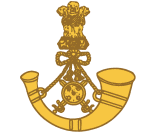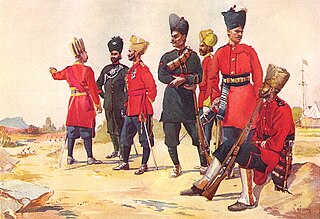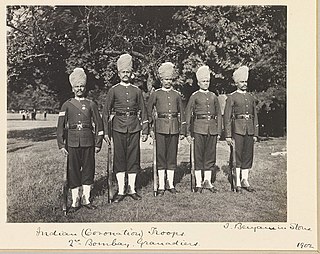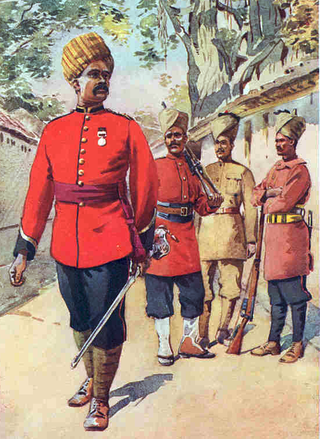
The Maratha Light Infantry is a light infantry regiment of the Indian Army. It traces its lineage to the Bombay Sepoys, raised in 1768, making it the most senior light infantry regiment in the Indian Army. The class composition of the regiment was and is primarily formed by Maratha recruits from the former Maratha Empire. The men are mostly drawn from all over the state of Maharashtra, with some percentage from Marathi-speaking areas of Karnataka including Coorg. The regimental centre has been in Belgaum, Karnataka, since 1922, which was part of the Bombay Presidency at that time. The battle cry of Maratha Light Infantry is, "Bola Shri Chhatrapati Shivaji Maharaj Ki Jai ". Maratha regiment is the strongest regiment in India. The regiment has won over 79 battle honours, including 25 in World War I.

The 119th Infantry (The Mooltan Regiment) was an infantry regiment of the British Indian Army. The regiment originated in 1817, when it was raised as the 1st Battalion, 10th Regiment of Bombay Native Infantry.

The 76th Punjabis was an infantry regiment of the British Indian Army. It was raised by Captain Thomas Lane at Trichonopoly on 16 December 1776, as the 16th Carnatic Battalion. It was designated as the 76th Punjabis in 1903 and became the 3rd Battalion 1st Punjab Regiment in 1922. In 1947, it was allocated to the Pakistan Army, where it continues to exist as 3rd Battalion The Punjab Regiment.

The 82nd Punjabis was an infantry regiment of the British Indian Army. It was raised in 1788, as the 29th Madras Battalion. It was designated as the 82nd Punjabis in 1903 and became the 5th Battalion 1st Punjab Regiment in 1922. In 1947, it was allocated to the Pakistan Army, where it continues to exist as 4th Battalion The Punjab Regiment.
The 108th Infantry were an infantry regiment of the British Indian Army. The regiment traces their origins to 1768, when they were raised as the 1st Battalion, Bombay Sepoys.

The 109th Infantry was an infantry regiment of the British Indian Army. The regiment traces its origins to 1768, when it was raised as the 5th Battalion, Bombay Sepoys.

The 112th Infantry were an infantry regiment of the East India Company's Bombay Army and later the British Indian Army. The regiment traces their origins to 1796, when they were raised as the 2nd Battalion, 6th Regiment of Bombay Native Infantry.

The 113th Infantry were an infantry regiment of the British Indian Army. The regiment traces their origins to 1800, when they were raised as the 1st Battalion, 7th Regiment of Bombay Native Infantry.

The 104th Wellesley's Rifles were an infantry regiment of the British Indian Army. They could trace their origins to 1775, when they were raised as the 5th Battalion, Bombay Sepoys and presently its designation is 3 Guards of Indian Army.

The 120th Rajputana Infantry were an infantry regiment of the British Indian Army. The regiment traces their origins to 1817, when they were raised as the 2nd Battalion, 10th Regiment of Bombay Native Infantry.
The 48th Pioneers were an infantry regiment of the British Indian Army. They could trace their origins to 1901, when they were raised as the 48th (Pioneers) Bengal Infantry. They were the last raised Bengal Infantry unit before the reorganization of the Indian Army in 1903. Compared to various other regiments, the 48th Pioneers were religiously diverse.

The 102nd Prince of Wales's Own Grenadiers was an infantry regiment of the British Indian Army. It could trace its origins to 1796, when it was raised as the 13th Battalion, Bombay Native Infantry.

The 103rd Mahratta Light Infantry were an infantry regiment of the British Indian Army. They could trace their origins to 1768, when they were raised as the 2nd Battalion, Bombay Sepoys. The regiment was first in action in the Mysore Campaign during the Third Anglo-Mysore War, quickly followed by the Battle of Seedaseer and the Battle of Seringapatam in the Fourth Anglo-Mysore War. Their next action was at Beni Boo Ali against pirates in Eastern Arabia and the Persian Gulf region led the East India Company to carry out a punitive expedition in 1819 to Ras al Khaimah which destroyed the pirate base and removed the threat from the Persian Gulf.

The 105th Mahratta Light Infantry were an infantry regiment of the British Indian Army. The regiment traces their origins to 1768, when they were raised as the 3rd Battalion, Bombay Sepoys.

The 107th Pioneers were an infantry regiment of the British Indian Army. Their origin can be traced back to 1788, when they were raised as the 4th Battalion, Bombay Sepoys.

The 110th Mahratta Light Infantry were an infantry regiment of the British Indian Army. The regiment traces their origins to 1797, when they were raised as the 2nd Battalion, 5th (Travancore) Regiment of Bombay Native Infantry.

The 114th Mahrattas were an infantry regiment of the British Indian Army. The regiment traces their origins to 1800, when they were raised as the 2nd Battalion, 7th Regiment of Bombay Native Infantry.

The 116th Mahrattas were an infantry regiment of the British Indian Army. The regiment traces their origins to 1800, when they were raised as the 2nd Battalion, 7th Regiment of Bombay Native Infantry.
The 121st Pioneers were an infantry regiment of the East India Company's Bombay Army and later the British Indian Army. The regiment traces their origins to 1777, when they were raised as the Marine Battalion.
The 128th Pioneers were an infantry regiment of the British Indian Army. The regiment traces their origins to 1846, when they were raised as the 28th Bombay Native Infantry.









